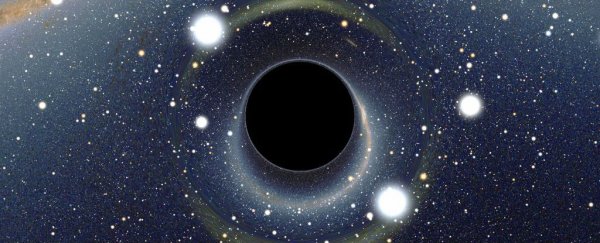Proposed by physicist Stephen Hawking back in 1974, Hawking radiation describes the small amounts of high-energy radiation that could theoretically escape the gravitational pull of a black hole.
The hypothesis goes against conventional wisdom that nothing, not even light, can escape a black hole, and now, for the first time, physicists have finally observed hawking radiation - in a simulated black hole.
Just to be clear, Hawking's hypothesis will remain just that until we can actually observe hawking radiation near a real-life black hole, but our technology is not nearly advanced enough to do that right now.
Instead, physicists test their hypotheses on black hole simulations created in the lab - based not on light, but on sound.
Proposed in the 1980s, but not actually built till 2009, these acoustic, or 'dumb' black holes are formed by cooling rubidium atoms to within a few billionths of a degree above absolute zero.
At this point, the atoms enter a quantum state of matter, where they start to behave like clones of each other, clumping up to form a 'super particle', or wave, known as a Bose-Einstein condensate (BEC).
Previous research has shown that these acoustic black holes - which also require a bunch of mirrors, lasers, lenses, and magnetic coils - do actually mimic the behaviour of real black holes in some crucial ways, so are considered a pretty good substitute.
Jeff Steinhauer, a physicist at the Israel Institute of Technology in Haifa, has been working on his acoustic black hole for seven years now, and has finally perfected it to the point where he could accurately simulate how particles would behave on the edge, or event horizon, of his black hole.
Incredibly, when he ran the experiment 4,600 times, what he saw was exactly what Hawking had predicted: pairs of phonons (packets of sound energy) started to spontaneously appear at the event horizon, before one was propelled away from the black hole and into simulated space, while the other was left to fall inside.
In case you need a bit of a refresher on Hawking radiation, the hypothesis is all wrapped up in an infamous problem in theoretical physics known as the black hole information paradox.
Hawking radiation proposes that the Universe is filled with virtual entangled particles that blink in and out of existence and annihilate each other as soon as they come in contact - except if they happen to appear on either side of a black hole's event horizon.
In this scenario, one particle gets swallowed up, and the other radiates away into space.
Thanks to this escaping radiation stealing energy from the black hole, the black hole loses mass over time, and eventually evaporates out of existence - taking all the information about what it swallowed with it.
So the paradox goes like this: according to Einstein's general theory of relativity, all matter that crosses the event horizon of a black hole is swallowed up forever, and can never be retrieved. But according to our understanding of quantum mechanics, information about that swallowed matter can never be completely destroyed, so which one is correct?
Earlier this year, Hawking published a 'solution' to the information paradox, which hasn't convinced everyone in the field, but basically suggests that black holes might actually have a halo of 'soft hair' surrounding them, which are capable of storing information, so it's not lost altogether. You can read more about that here.
So now back to Steinhauer and his team. After running their acoustic black hole experiment for six days straight, the researchers took pictures of the BEC and showed that the phonons escaping were in fact 'entangled' with the ones falling in.
"We saw that high energy pairs were entangled, while low energy pairs were not," he told Sarah Griffths at Wired.
"We observe a thermal distribution of Hawking radiation, stimulated by quantum vacuum fluctuations, emanating from an analogue black hole. This confirms Hawking's prediction regarding black hole thermodynamics."
Steinhauer added that the particles exciting the event horizon generated so much energy, the simulation also supports the firewall controversy - a separate hypothesis that suggests the breaking of the entanglement between the Hawking particles and their partners generates enough energy to create an actual wall of flames at the edge of a black hole. More on that hypothesis here.
It will take a whole lot more replication and confirmation to prove the results - some doubt that the BEC they've created is actually a true BEC - and only direct observations from real black holes will put Hawking in the running for a Nobel Prize. But Steinhauer and his team could really be on to something here.
"You're probing this feature of gravity that is very hard to probe experimentally with real black holes," Stephen Fairhurst, a professor at Cardiff University's school of physics and astronomy, who was not involved in the study, told Tom Chivers at Buzzfeed.
"Quite how these things can teach us about quantum gravity I'm not sure, but that's surely the next goal - seeing how we can translate this into relativity."
The results have been published in Nature Physics.
